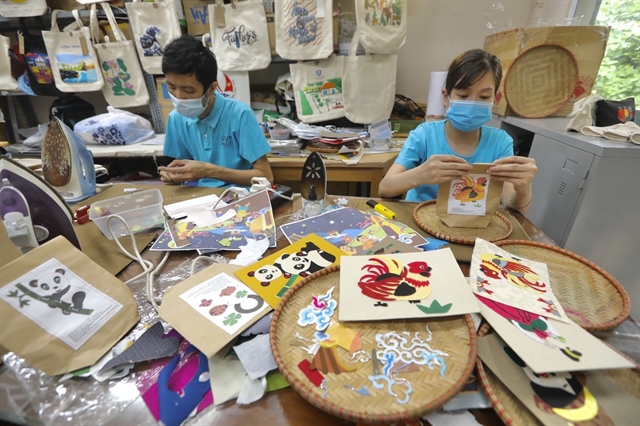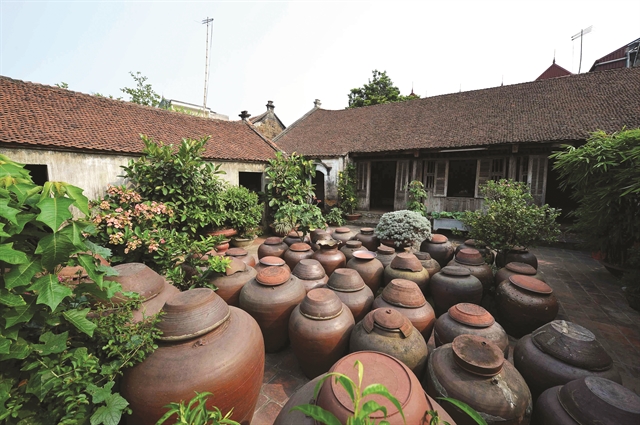Products that meet the criteria of the One Commune One Product (OCOP) programme have been helping boost tourism in the capital city of Ha Noi.

People make products from scraps of clothing at Vun Art Co-operative in Van Phuc silk craft village in Ha Dong District. The products are certified as 4-star OCOP products of Ha Noi. — Photo courtesy of The Department of Agriculture and Rural Development
Ha Noi is the home of 1,205 festivals and 1,350 craft villages, and many relics and festivals have been recognised by UNESCO.
The city has 1,342 agricultural co-operatives and, of them, 84 co-operatives have established links between production and consumption. There are also more than 100 high-tech agricultural models.
Ha Noi now has 1,649 OCOP items, leading the country in the number of certified products.
These are promising factors that could promote rural tourism in the city.
Thanh Xuan Organic Vegetable Co-operative in the suburban district of Soc Son has had its vegetable recognised as a "4-star OCOP product" as it satisfies all criteria relating to growing areas, and food safety and hygiene.
Its organic vegetable farm not only helps the co-operative supply 20-25 tonnes of products to the market each month, generating revenue of VND450-500 million per month, but is also a specialised location for education and tourism experiences.
The number of visitors to the farm depends on the season, mainly in the summer and winter, and the co-operative attracts about 35-50 groups of visitors each year.
The visitors are mainly students from kindergartens and primary schools in Ha Noi and neighbouring provinces.
As a result, the co-operative reaches a total yearly revenue of billions of Vietnamese dong.
Meanwhile, a new model of rural tourism in Bat Trang craft village is proving successful.

Bat Trang ceramics village in Bat Trang commune, Gia Lam District, has many products recognised as 4-star and 5-star by OCOP. — Photo courtesy of The Department of Agriculture and Rural Development
OCOP products of local co-operatives, including Bat Trang Ancient Village Tourism Service - Trade Co-operative or Tan Thinh Ceramics Production and Business Cooperative, are used to attract tourists. This helps boost consumption of agricultural products and OCOP products locally, especially in suburban areas.
The use of OCOP products in conducting rural tours helps co-operatives take advantage of their potential strengths, raise incomes, and promote the economy and culture in rural areas.
When tourism products are recognised as OCOP products, more tourists will know about them, and their value is enhanced.
Seeing the advantages of OCOP products, Ha Noi plans to continue to support co-operatives and destinations to develop community-based tourism and traditional craft village tourism products.
The city authority will also build a mechanism to support investment in developing rural tourism and craft villages, particularly in terms of cultural value preservation and job training.
It is expected that in 2022-2025, the city will achieve the goal that each district and town has potential and strengths in developing agricultural and rural tourism, deploying one to three products to facilitate the development of community tourism services.

Duong Lam ancient village in Son Tay Town, is one of five localities piloted to introduce and promote OCOP products associated with craft village tourism and rural tourism. — Photo courtesy of The Department of Agriculture and Rural Development
The city's Department of Agriculture and Rural Development has targeted at least half of the tourism products to be protected by intellectual property rights and recognised as 3-star OCOP products or higher.
Nguyen Van Chi, Deputy Chief of the Standing Office of the city's New Rural Construction Programme Coordination Office, said that the OCOP programme was an opportunity for stakeholders to develop product values, build brands, boost economic development and realise the new rural area building programme.
Director of the Ha Noi's Department of Agriculture and Rural Development Chu Phu My said that OCOP producers needed to maintain and improve the quality, design, and packaging of products and strengthen links between production and consumption.